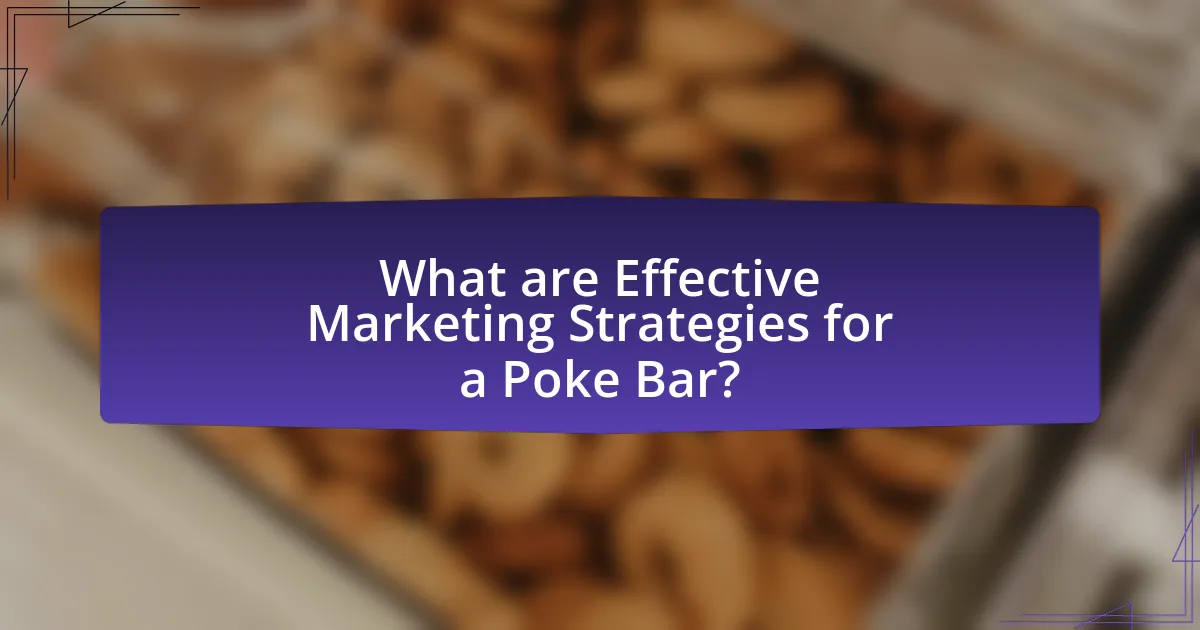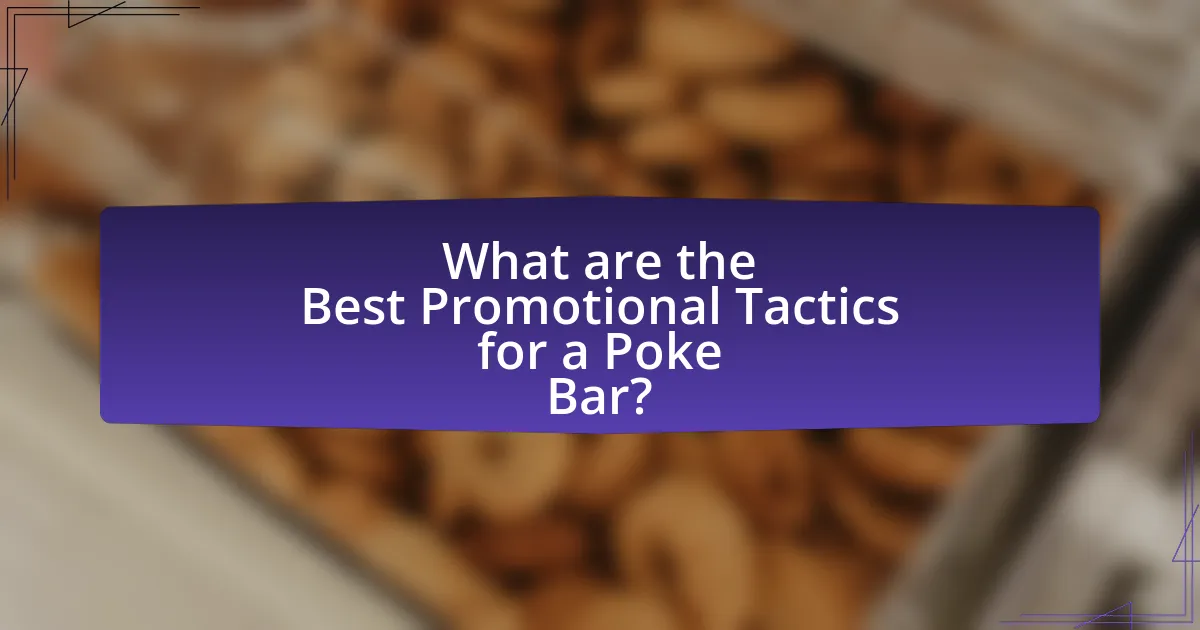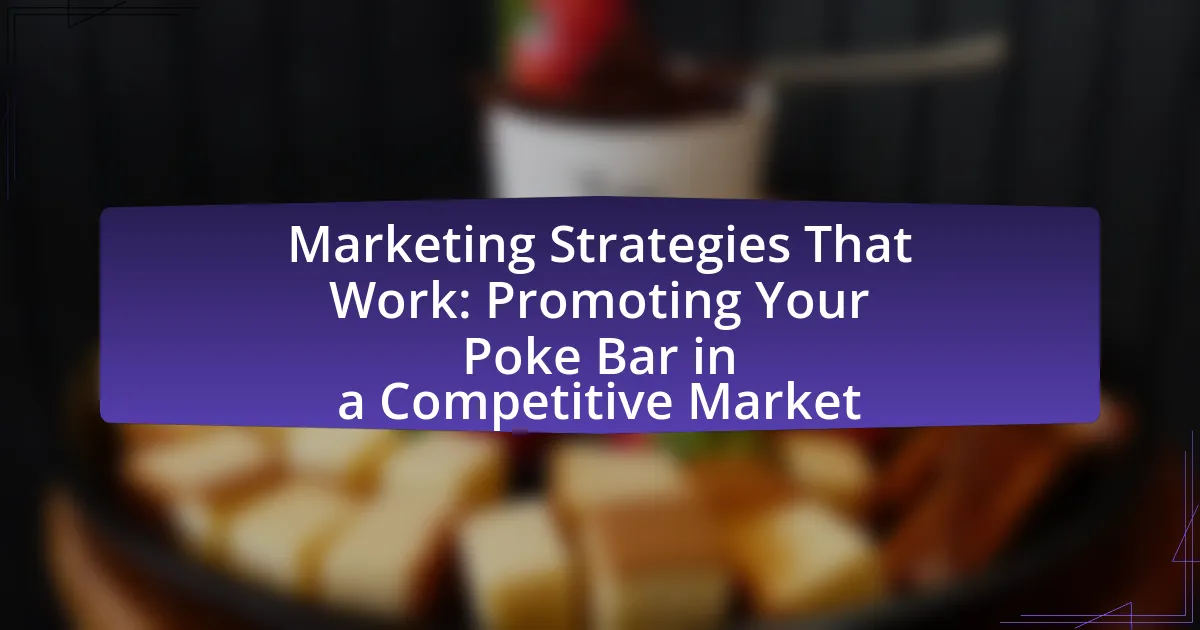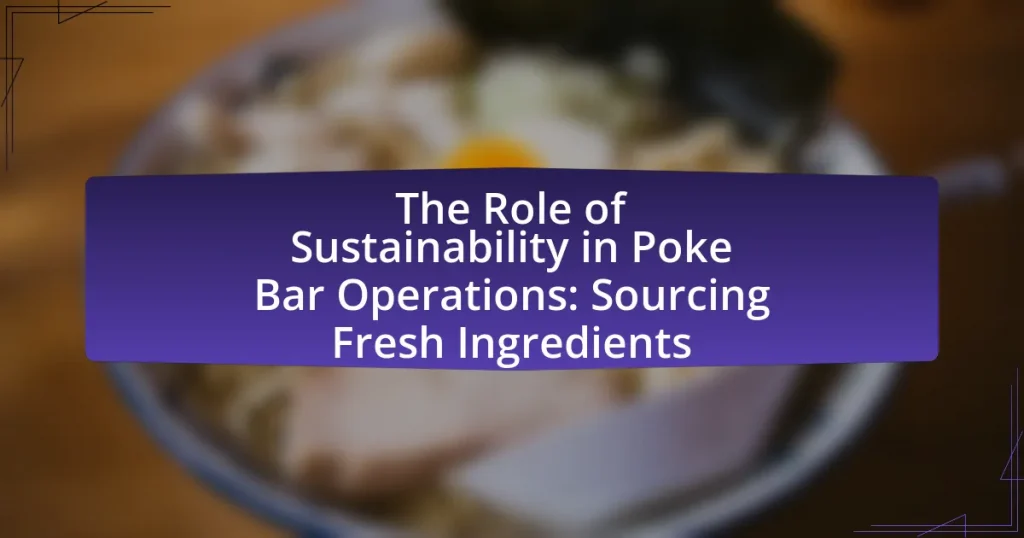The article focuses on effective marketing strategies for promoting a poke bar in a competitive market. It emphasizes the importance of leveraging social media, understanding target demographics, and creating a unique customer experience to attract health-conscious consumers aged 18 to 35. Key tactics discussed include utilizing promotions, local partnerships, and loyalty programs to enhance customer engagement and retention. Additionally, the article highlights the significance of branding, customer feedback, and performance metrics in refining marketing efforts and overcoming common challenges in the industry.

What are Effective Marketing Strategies for a Poke Bar?
Effective marketing strategies for a poke bar include leveraging social media, offering promotions, and creating a unique customer experience. Social media platforms like Instagram and Facebook are essential for showcasing visually appealing poke bowls, engaging with customers, and running targeted ads. Promotions such as discounts for first-time customers or loyalty programs can incentivize repeat visits. Additionally, creating a unique in-store experience, such as customizable bowls and interactive elements, can differentiate the poke bar from competitors and enhance customer satisfaction. These strategies are supported by the fact that 73% of consumers are more likely to visit a restaurant with an active social media presence, according to a study by the National Restaurant Association.
How can understanding your target audience enhance your marketing efforts?
Understanding your target audience enhances marketing efforts by allowing businesses to tailor their messaging, products, and services to meet the specific needs and preferences of potential customers. This targeted approach increases engagement and conversion rates, as marketing strategies resonate more effectively with the audience. For instance, research by HubSpot indicates that personalized marketing can lead to a 20% increase in sales. By analyzing demographics, behaviors, and preferences, businesses can create more relevant content and offers, ultimately driving customer loyalty and improving overall marketing ROI.
What demographics should you focus on for your poke bar?
Focus on health-conscious individuals aged 18 to 35 for your poke bar. This demographic is increasingly seeking fresh, nutritious meal options, with a growing trend towards plant-based and seafood diets. According to a report by the International Food Information Council, 70% of millennials prioritize healthy eating, making them a prime target for poke offerings that emphasize fresh ingredients and customization. Additionally, urban areas with high concentrations of young professionals and college students present significant opportunities, as these consumers often value convenience and unique dining experiences.
How can customer preferences shape your marketing strategies?
Customer preferences significantly shape marketing strategies by guiding product offerings, promotional tactics, and customer engagement methods. Understanding what customers value—such as freshness, sustainability, or unique flavor combinations—allows businesses to tailor their menu and marketing messages accordingly. For instance, a survey by Mintel found that 60% of consumers prefer restaurants that offer locally sourced ingredients, indicating that emphasizing local sourcing in marketing can attract more customers. Additionally, analyzing customer feedback and purchasing behavior enables businesses to refine their strategies, ensuring they meet evolving preferences and remain competitive in the market.
What role does branding play in promoting your poke bar?
Branding plays a crucial role in promoting your poke bar by establishing a unique identity that differentiates it from competitors. A strong brand creates recognition and loyalty among customers, which is essential in a competitive market. For instance, a well-defined brand can lead to a 20% increase in customer retention, as reported by the Harvard Business Review. Additionally, effective branding communicates the values and quality of your poke bar, influencing customer perceptions and driving sales.
How can a strong brand identity attract customers?
A strong brand identity attracts customers by creating a recognizable and trustworthy image that resonates with their values and preferences. This recognition fosters customer loyalty, as consumers are more likely to choose brands that they feel a connection with. According to a study by Nielsen, 59% of consumers prefer to buy new products from brands familiar to them, highlighting the importance of brand identity in influencing purchasing decisions. Additionally, a well-defined brand identity differentiates a business from competitors, making it easier for customers to identify and choose it in a crowded market.
What elements contribute to effective branding for a poke bar?
Effective branding for a poke bar is primarily influenced by unique identity, quality ingredients, customer experience, and visual aesthetics. A unique identity differentiates the poke bar from competitors, establishing a memorable brand presence. Quality ingredients are essential, as they directly impact customer satisfaction and loyalty; studies show that fresh, high-quality offerings lead to repeat business. Customer experience encompasses service quality and ambiance, which can enhance brand perception and encourage word-of-mouth referrals. Visual aesthetics, including logo design, color schemes, and packaging, play a crucial role in attracting customers and creating a cohesive brand image. Together, these elements create a strong brand that resonates with consumers in a competitive market.
How can social media be leveraged to promote your poke bar?
Social media can be leveraged to promote your poke bar by creating engaging content that showcases menu items, customer experiences, and special promotions. Utilizing platforms like Instagram and Facebook allows for visually appealing posts that highlight the freshness and variety of poke bowls, attracting potential customers. According to a 2021 survey by Sprout Social, 79% of consumers prefer to engage with brands on social media, indicating that active engagement can significantly enhance brand visibility and customer loyalty. Additionally, running targeted ads on these platforms can reach specific demographics interested in healthy dining options, further increasing foot traffic to your poke bar.
Which social media platforms are most effective for food businesses?
Instagram and Facebook are the most effective social media platforms for food businesses. Instagram’s visual-centric approach allows food businesses to showcase appealing images and videos of their dishes, which can drive engagement and attract customers. According to a 2021 survey by the National Restaurant Association, 77% of consumers are influenced by social media when deciding where to eat, with Instagram being a key platform for food discovery. Facebook, with its extensive user base and targeted advertising options, enables food businesses to reach specific demographics effectively, enhancing customer engagement and loyalty.
What types of content should you share to engage your audience?
To engage your audience, share visually appealing content, such as high-quality images and videos of your poke bar’s dishes. Research indicates that posts with images receive 94% more views than those without, highlighting the importance of visual content in attracting attention. Additionally, sharing user-generated content, such as customer reviews and photos, fosters community engagement and builds trust, as 79% of consumers say user-generated content highly impacts their purchasing decisions. Informative content, like recipes or nutritional information, also engages audiences by providing value, with 70% of consumers preferring brands that offer educational content.

What are the Best Promotional Tactics for a Poke Bar?
The best promotional tactics for a poke bar include social media marketing, local partnerships, and loyalty programs. Social media marketing effectively engages customers by showcasing vibrant poke bowl images and special promotions, which can increase brand visibility and customer interaction. Local partnerships with gyms or health-focused businesses can attract health-conscious consumers, leveraging cross-promotion to reach a wider audience. Implementing loyalty programs encourages repeat visits, as studies show that 70% of consumers are more likely to recommend a business with a good loyalty program. These tactics collectively enhance customer engagement and drive sales in a competitive market.
How can local partnerships enhance your marketing reach?
Local partnerships can significantly enhance your marketing reach by leveraging shared audiences and resources. Collaborating with nearby businesses allows for cross-promotion, where each partner can introduce their customer base to the other’s offerings, thereby expanding visibility. For instance, a poke bar partnering with a local gym can attract health-conscious customers who frequent the gym, increasing foot traffic and brand awareness. Research indicates that businesses engaged in local partnerships experience a 20% increase in customer engagement, as they tap into established trust within the community. This strategy not only broadens market exposure but also fosters a sense of community, making the poke bar a preferred choice among local consumers.
What types of businesses should you partner with for cross-promotion?
To effectively cross-promote, partner with businesses that share a similar target audience but offer non-competing products or services. For example, a poke bar can collaborate with health food stores, gyms, or wellness centers, as these establishments attract health-conscious consumers who are likely to appreciate poke offerings. This strategy is supported by the fact that 70% of consumers are more likely to engage with brands that partner with other trusted brands, enhancing visibility and credibility in the market.
How can community events boost your poke bar’s visibility?
Community events can significantly boost your poke bar’s visibility by attracting local customers and creating brand awareness. When a poke bar participates in or sponsors community events, it engages directly with potential customers, fostering relationships and encouraging foot traffic. For instance, a study by the National Restaurant Association found that 70% of consumers are more likely to visit a restaurant that supports local events. This direct engagement not only enhances visibility but also builds a positive community reputation, leading to increased customer loyalty and repeat visits.
What role do promotions and discounts play in attracting customers?
Promotions and discounts play a crucial role in attracting customers by creating immediate incentives for purchase. These strategies effectively lower the perceived cost of products or services, making them more appealing to potential buyers. For instance, a study by the Journal of Marketing Research found that limited-time offers can increase sales by up to 30%, as urgency drives consumer behavior. Additionally, promotions can enhance brand visibility and encourage trial among new customers, leading to increased foot traffic and customer acquisition in competitive markets.
How can limited-time offers create urgency among potential customers?
Limited-time offers create urgency among potential customers by instilling a fear of missing out, prompting immediate action. This psychological trigger encourages consumers to make quicker purchasing decisions to avoid losing the opportunity. Research indicates that urgency can increase conversion rates significantly; for instance, a study by the Journal of Marketing found that limited-time promotions can boost sales by up to 30% compared to standard offers. By emphasizing scarcity and time constraints, businesses effectively motivate potential customers to prioritize their purchases, leading to increased sales and customer engagement.
What are effective ways to implement loyalty programs?
Effective ways to implement loyalty programs include offering tiered rewards, personalized incentives, and easy enrollment processes. Tiered rewards encourage customers to spend more to reach higher levels of benefits, which can increase overall sales. Personalized incentives, such as discounts on favorite items or birthday rewards, enhance customer engagement and satisfaction. Easy enrollment processes, such as mobile app sign-ups or automatic enrollment at checkout, increase participation rates. According to a study by Bond Brand Loyalty, 79% of consumers are more likely to engage with a brand that has a loyalty program, demonstrating the effectiveness of these strategies in driving customer retention and sales.
How can customer feedback improve your marketing strategies?
Customer feedback can significantly enhance marketing strategies by providing insights into customer preferences and behaviors. By analyzing feedback, businesses can identify what aspects of their offerings resonate with customers, allowing for targeted marketing efforts that align with consumer desires. For instance, a study by the Harvard Business Review found that companies that actively seek and respond to customer feedback can increase customer retention rates by up to 15%. This data underscores the importance of integrating customer insights into marketing strategies to create more effective campaigns and improve overall customer satisfaction.
What methods can you use to gather customer feedback?
To gather customer feedback, businesses can utilize surveys, interviews, focus groups, and online reviews. Surveys, often distributed via email or social media, allow for quantitative data collection and can yield insights into customer satisfaction and preferences. Interviews provide qualitative feedback through direct conversations, enabling deeper understanding of customer experiences. Focus groups facilitate discussions among selected customers, generating diverse perspectives on products or services. Online reviews on platforms like Google or Yelp offer real-time feedback and can influence potential customers’ decisions. These methods are effective as they provide actionable insights that can enhance customer experience and inform marketing strategies.
How should you respond to customer reviews to enhance your reputation?
To enhance your reputation, respond to customer reviews promptly and professionally. Timely responses show that you value customer feedback, which can improve customer loyalty and attract new patrons. A study by BrightLocal found that 89% of consumers read responses to reviews, indicating that engaging with reviews can positively influence potential customers’ perceptions. Additionally, addressing negative reviews constructively can demonstrate your commitment to customer satisfaction and willingness to resolve issues, further solidifying your reputation in a competitive market.

What are the Key Metrics to Measure Marketing Success for Your Poke Bar?
The key metrics to measure marketing success for your poke bar include customer acquisition cost (CAC), customer lifetime value (CLV), return on investment (ROI), social media engagement, and sales growth. Customer acquisition cost quantifies the expense incurred to attract a new customer, while customer lifetime value estimates the total revenue generated from a customer over their relationship with the business. Return on investment evaluates the profitability of marketing campaigns by comparing the revenue generated to the costs incurred. Social media engagement metrics, such as likes, shares, and comments, indicate brand awareness and customer interaction. Lastly, sales growth reflects the effectiveness of marketing strategies in driving revenue. These metrics provide a comprehensive view of marketing performance and inform strategic adjustments.
How can you track the effectiveness of your marketing campaigns?
To track the effectiveness of your marketing campaigns, utilize key performance indicators (KPIs) such as conversion rates, customer acquisition costs, and return on investment (ROI). These metrics provide quantifiable data that reflects the success of your campaigns. For instance, a study by HubSpot found that businesses that actively measure their marketing performance are 1.5 times more likely to see a positive ROI. Additionally, tools like Google Analytics can help monitor website traffic and user behavior, allowing for real-time adjustments to improve campaign effectiveness.
What tools can help you analyze customer engagement and sales data?
Tools that can help analyze customer engagement and sales data include Google Analytics, HubSpot, and Tableau. Google Analytics provides insights into website traffic and user behavior, allowing businesses to track engagement metrics effectively. HubSpot offers comprehensive marketing analytics, enabling users to measure the performance of campaigns and customer interactions. Tableau is a powerful data visualization tool that helps businesses analyze complex data sets, making it easier to identify trends in customer engagement and sales performance. These tools are widely used in the industry, with Google Analytics reporting over 28 million active users, demonstrating their effectiveness in data analysis.
How can you adjust your strategies based on performance metrics?
To adjust your strategies based on performance metrics, analyze key performance indicators (KPIs) such as customer acquisition cost, conversion rates, and customer retention rates. By evaluating these metrics, you can identify areas of strength and weakness in your marketing efforts. For instance, if customer acquisition costs are high, consider reallocating your budget to more effective channels or optimizing your advertising campaigns. Additionally, if conversion rates are low, you may need to refine your messaging or improve your website’s user experience. Data from a 2022 HubSpot report indicates that businesses that regularly analyze performance metrics are 2.5 times more likely to achieve their marketing goals, underscoring the importance of data-driven adjustments.
What are common challenges in marketing a poke bar?
Common challenges in marketing a poke bar include differentiating the brand in a saturated market, managing food quality and freshness, and effectively reaching target demographics. The poke bar industry has seen significant growth, with the number of poke restaurants increasing by over 300% in recent years, leading to intense competition. Additionally, maintaining high-quality ingredients is crucial, as customers expect freshness and authenticity, which can complicate supply chain management. Lastly, effectively targeting health-conscious consumers and millennials through digital marketing strategies is essential, as these demographics are key to driving sales in the poke bar sector.
How can you differentiate your poke bar in a saturated market?
To differentiate your poke bar in a saturated market, focus on unique menu offerings and exceptional customer experience. By introducing innovative ingredients, customizable options, and seasonal specials, you can attract diverse customer preferences. For instance, incorporating locally sourced fish or unique sauces can set your poke bar apart. Additionally, enhancing customer experience through personalized service, loyalty programs, and engaging social media presence can foster customer loyalty. Research indicates that businesses with strong customer engagement strategies see a 23% increase in profitability, highlighting the importance of these approaches in a competitive landscape.
What strategies can help you overcome budget constraints in marketing?
To overcome budget constraints in marketing, focus on leveraging cost-effective digital marketing strategies such as social media marketing, content marketing, and email marketing. These strategies allow for targeted outreach and engagement without the high costs associated with traditional advertising methods. For instance, social media platforms like Instagram and Facebook enable businesses to reach specific demographics at minimal costs, with 73% of marketers believing that their efforts through social media marketing have been “somewhat effective” or “very effective” for their business (Buffer, 2021). Additionally, creating valuable content can enhance brand visibility and customer loyalty, as 70% of consumers prefer to learn about a company through articles rather than ads (Content Marketing Institute, 2022). Email marketing also offers a high return on investment, with an average ROI of $42 for every dollar spent (Litmus, 2021). By utilizing these strategies, businesses can effectively market their offerings while adhering to budget limitations.
What are some practical tips for promoting your poke bar effectively?
To promote your poke bar effectively, utilize social media marketing to engage with potential customers and showcase your menu. Platforms like Instagram and Facebook allow you to share visually appealing images of your poke bowls, which can attract attention and encourage sharing. Additionally, consider offering promotions or discounts to first-time customers, as studies show that 60% of consumers are motivated by discounts when trying a new restaurant. Collaborating with local influencers can also enhance visibility; research indicates that influencer marketing can yield an ROI of up to $6.50 for every dollar spent. Finally, hosting events or tastings can create buzz and foster community engagement, driving foot traffic to your poke bar.



